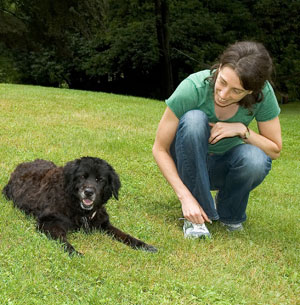
- Inside of a Dog: What Dogs See, Smell and Know
- Scribner (2009)
Even we who love dogs take them for granted. Dogs, however, study us carefully and constantly. As a result, they know us better than we know ourselves.
Alexandra Horowitz, a Barnard College psychology professor, has returned the compliment in this very readable book. Not only do we learn a lot about dogs, but we learn a lot about ourselves.
We also unlearn a lot. I'd thought dogs are colour-blind; they do see colours, mostly blues, greens, and yellows. And while sight is not as important as smell to them, they see better in many ways. We can see in a range of about 180°, but dogs have a wide-screen world of up to 270°.
They see better in the dark because light reflects off their retinas and back again, effectively doubling the signal. Dogs also see "faster" -- we process images at the rate of about 60 per second, but dogs process 70 to 80 images per second. That makes TV as boring for them as a PowerPoint presentation, but it also means they can track a Frisbee with amazing accuracy.
We also unlearn the old idea that dogs are "pack animals" trying to figure out who's the alpha in the pack. That's true for wolves, but we seem to have bred that trait out of dogs over the past 10,000 years.
You can't keep secrets from a dog's nose
Of course, it's their sense of smell that most impresses us. Horowitz says our noses have about six million receptor sites that pick up scents. Beagles have three hundred million sites. "Dogs," she says, "have more genes committed to coding olfactory cells, more cells, and more kinds of cells, able to detect more kinds of smells."
Fortunately for them, humans are highly stinky, and each of us has our own distinct scent. Even if we're freshly showered and dressed in new clothes, our dogs can identify us with a quick nose to the crotch.
Many writers about dogs are most concerned to determine how much (or how little) dogs are like us. Horowitz takes a wiser approach: She tries to get into the dog's "umwelt," its self-world, and to perceive that world as the dog does.
That world is usually rich in humans, so dogs have become, in her word, "anthropologists," students of our behaviour. They look us in the eye, or at least at our faces, because we're sources of useful information. They also follow our gaze, because we always look before we do something. If we're staring at TV or a computer screen, they have a range of attention-getting devices. A morose look or a yelp means breakfast is late. Barking frantically means the mail has just arrived.
How self-aware are dogs?
As a psychologist, Horowitz is interested in whether dogs have a "theory of mind" -- an awareness of themselves and others as thinking beings. They don't seem to recognize themselves in mirrors (though they'll use mirrors to look around corners). But if a dog is distracted while playing, his playmate will use an attention-getting device that seems carefully chosen for the level of distraction.
We often debate whether dogs are smarter than cats, and which dog breeds are smartest. This is actually another attempt to anthropomorphize our pets. In one set of tests, a dog was expected to find a ball in one of a number of locked boxes, with the key somewhere else. When a person came into the room, the dog looked at where the key was hidden; evidently he expected the person to follow his gaze, extract the key, and then use it to unlock the box and give him the ball.
This was closely analogous to a chimp using a pole to get an out-of-reach banana. Whether by knocking the banana down, or climbing the pole to grab the banana before the pole topples, the chimp is using a tool.
In the ball experiment, the dog was in effect using the human as a tool. He may not have known how humans make locks and keys, and he couldn't use a key himself. But just as we use computers without knowing how they work, the dog was using a human to solve a problem.
Who's breeding whom?
We created dogs through tens of thousands of years of conscious selection for useful traits. Horowitz cites a Russian research program that duplicated this achievement in only forty years, turning wild silver foxes into very doglike animals .
But it wasn't all one way. Bred to pay attention to humans, dogs understand us better than we understand them, and they have made us a convenient part of their umwelt: We are literally their go-to guys, providing all kinds of useful services.
Also bred to do work for humans, dogs appear to have turned the tables. Now we work for them, and we've built multi-billion-dollar industries to feed, shelter, train, and even clothe our dogs, not to mention their medical care. Considered from that point of view, dogs are far smarter than we are.
By giving us a glimpse into the dog's world, Horowitz shows us how to expand our own. "Go look at your dog," she says. "Go to him. Imagine his umwelt -- and let him change your own." ![]()















Tyee Commenting Guidelines
Comments that violate guidelines risk being deleted, and violations may result in a temporary or permanent user ban. Maintain the spirit of good conversation to stay in the discussion.
*Please note The Tyee is not a forum for spreading misinformation about COVID-19, denying its existence or minimizing its risk to public health.
Do:
Do not: